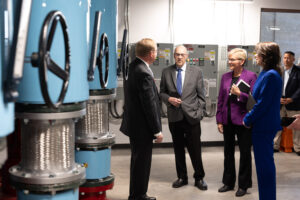
U.S. Department of Energy Secretary Jennifer Granholm visited the University of Utah campus Wednesday, Feb. 8, to meet with the research team behind the U’s Frontier Observatory for Research in Geothermal Energy (FORGE), the country’s largest geothermal energy laboratory built in Milford, Utah.
Granholm arrived at the Carolyn and Kem Gardner Commons building on campus and was briefed about the progress of the FORGE lab, which is designed to develop new technologies in geothermal energy. Joining her were Utah Lt. Gov Deidre Henderson, officials from the Utah Office of Energy Development, the University of Utah, and the Energy & Geoscience Institute, which manages the Utah FORGE research. Several students working on the project also attended.
Afterwards, Granholm also announced Wednesday that the DOE will provide up to $74 million in funding for up to seven new pilot projects around the country to test the scalability and effectiveness of geothermal systems, which capture the Earth’s abundant heat resources in different geologic settings for electricity. Details about the funding opportunity are available here.

University of Utah civil and environmental engineering research professor Joseph Moore, who is the principal investigator of Utah FORGE, presented an overview of the project and answered questions from Granholm and others in attendance. She expressed enthusiasm for the potential offered by the research in Enhanced Geothermal Systems, the progress achieved thus far, and its role in advancing the nation’s renewable energy goals.
Following the presentation, the secretary, Henderson and Moore toured the geothermal pump room at Gardner Commons. The building, located next to the university’s Student Union building, is entirely heated and cooled by some 150 geothermal wells located under a nearby soccer field, saving the university more than $60,000 annually in energy costs.
“The research that’s being done, is to make the heat beneath our feet, geothermal, available anywhere. And that’s what’s very exciting about the enhanced geothermal systems,” Granholm said Wednesday.
“And if we do this right, we will have another affordable, powerful, clean, dispatchable, baseload source of power for Utah and for the rest of the nation,” she added.

The Utah FORGE laboratory, which is also led by U chemical engineering professor John McLennan, is dedicated to developing the tools and technologies required for reservoir creation and management. Emphasis is placed on improved drilling techniques and bit designs, isolation tools, stimulating fractures from cased wells, fracture imaging technologies, managing induced seismicity, and reservoir characterization.
Once formed, these Enhanced Geothermal Systems (EGS) can provide environmentally clean, renewable and sustainable energy anywhere in the world. According to the U.S. Department of Energy, EGS has the potential to supply power to tens of millions of homes in the United States.
The $220 million geothermal energy laboratory, which is funded by the U.S. Department of Energy, is located within Utah’s Renewable Energy Corridor, already home to two geothermal plants, a wind farm, a solar field, and a biogas facility.